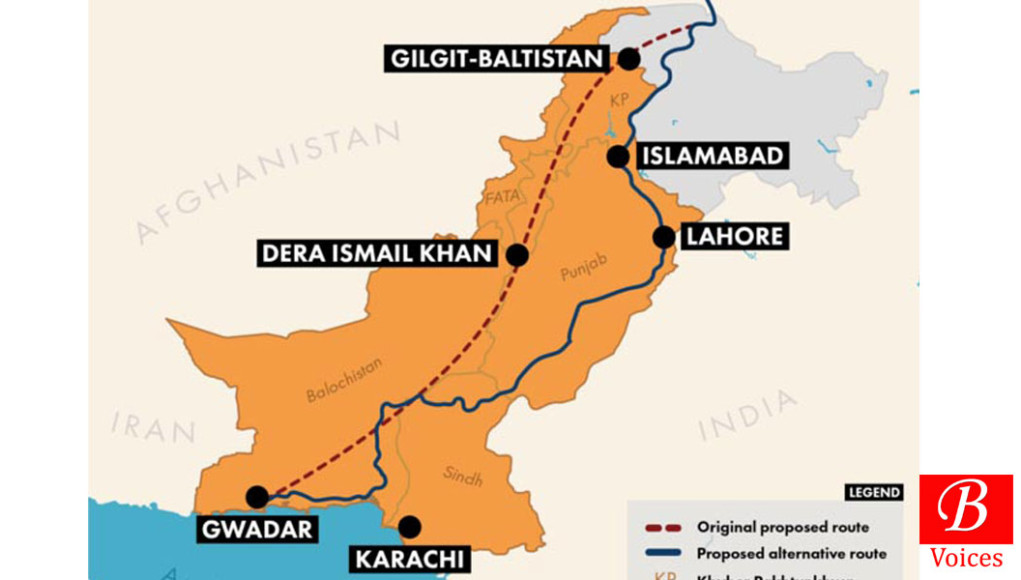China-Pakistan Economic Corridor (CPEC) has rightly been termed a game-changer enterprise. It has on its disposal all to help transform interregional and intraregional approaches from geopolitics into geo-economics. As a matter of fact, South Asian and Central Asian regions have hitherto been subjected to geopolitics and the gigantic potential of geo-economics has always been neglected. Hence the CPEC scheme promises endless dividends to the regions, and particularly to Pakistan and China. But inside Pakistan design of the enterprise appears to have been subjected to parochial power politics.
For China CPEC represents an important element of its Great Western Development Strategy. The western China includes five autonomous regions and one municipality. This region covers 71.4 percent of China’s mainland, abodes only 28.8 percent population and its share of economic output constitutes only 19.9 percent.
The aforesaid facts and figures about the western Chinese region reflect the both vulnerabilities and opportunities the region offers to the rest of the country.
Western China covers 71.4 percent of China’s mainland, abodes only 28.8 percent population and its share of economic output constitutes only 19.9 percent
China realizes the fact that for national sustainable economic growth it is of prime importance to ensure interregional socioeconomic harmony by reducing regional socioeconomic disparities. Such realization is based on the fact that only equitable and inclusive economic policy can lead to neutralize polarization and disharmony within the Chinese frontiers. China also acknowledges that only zero-conflict inside China could facilitate materializing its national, regional and global economic ambitions.
Read Also: Not a single Paisa Spent on CPEC Western Alignment – Concedes NHA
The domestic zero-conflict doctrine has compelled China to orchestrate a robust development package and reach out to the vulnerable Chinese pockets thus nipping potential threats in the bud. The Western Chinese region, the long-neglected and vulnerable pocket, offers all that can thwart Chinese political and economic ambitions. Hence the region has been chosen for socio-economic development by transforming it from a consumer market into manufacturing engine.
Also to China’s credit is the realization that the vulnerable western region clearly offers future trends of polarization of various shades. One possible polarization may be based on ethnicity and religious considerations with having roots in socioeconomic backwardness. China knows the existential vulnerability of the region, if not attended adroitly, could lead to ugly developments that China cannot afford given its grand global economic plans.
Whereas, regrettably, CPEC’s Pakistan chapter has apparently been subjected to power politics rather than employing it as a tool for socioeconomic transformation, particularly for regions that are alienated, marginalized and underdeveloped. Given the faulty and narrowly-orchestrated design of CPEC in Pakistan, the hovering controversies over it should not be unnatural.
Read also: CPEC and Chinese Economic Expansionism
Clearly, the PML (N), which draws most of its political power from Punjab, policy to retain and consolidate the Punjab constituency, the sole kingmaker constituency in Pakistan, appears to have impacted the overall design of CPEC in Pakistan. As a result of such parochial consideration, the party has turned the flow of resources towards the Punjab province that characterizes in its intransigence over the eastern route. Viewed CPEC in this perspective, it represents itself a game-changer for PML (N) future power prospects in the country.
CPEC has become a game-changer for PML (N) future power prospects in the country
The decision of the PML (N) to concentrate inputting to the eastern route will surely exacerbate the prevalent sense of deprivation in the Khyber Pakhtunkwa and Balochistan provinces. The key question is whether the two deprived provinces can further afford another show of endemic power politics? Can the country, already entangled in multiple imbroglios, afford further ugly policy decisions based on parochialism and provincialism? Ironically, it’s the smaller provinces that have always been labeled with particularism and provincialism. Equally alarming is behavior of the party that has tried to equate dissenting voices to conspiracy.
Amidst all controversy over the question of inputting resources under CPEC, a logic in favor of the western route goes as: first, it facilitates realizing the objective of cohesion of underdeveloped and turbulent regions of KP and Balochistan with the mainstream national political and economic infrastructure; second, it can potentially turn ultra-militarized regions into places of economic opportunities that could lead to socio-economic transformation of the alienated people; and lastly, the regions are lying at the doorstep of Central Asia and Middle East that are believed to be potential trade destinations of China via Pakistan.
Ironically, the project that inherently conceives the idea of putting the region on the trajectory of geo-economics has been fallen prey to parochial power politics in Pakistan. The elements of empowerment and equity have been subjected to the narrow interest of a political party.
Consensus must be built in Pakistan over the future direction of the project because a variety of regional and global players appear to be approaching it resentfully. Clearly, efforts are underway aiming to contain China’s power in all directions. China’s CPEC direction seems to be the most sensitive of all given its immense strategic importance for both Pakistan and China.
Writer is a featured columnist for Balochistan Voices. Click Here to read more articles written by this author.
Share your comments!








